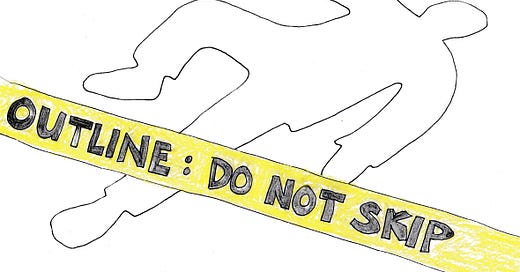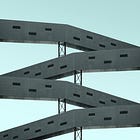How I Write My First Drafts Faster: An Ode to an Outline
Writing a screenplay can feel so daunting with those 100+ blank pages staring you down. My method of outlining will take some of the time, effort and terror out of facing the first draft.
When I sit down to write a feature script, I approach it like I’m about to paint a room.
The first room I ever painted was when I was 18 years old. It was my first real apartment and I felt exceedingly grown up. Possessing the pluckiness of someone who has no idea what they are getting themselves into, I decided to paint the walls, trim and ceiling. All. Different. Colours.
I walked in with three cans of paint, a single paintbrush and a solitary roller (no pole). What did I do first? I cracked that first can open and started slapping paint on the walls. The whole process took forever. It was agonizing. I wanted to quit halfway through. And in the end, it looked like shit. The whole ordeal made me never want to paint another room again.
Since then, experience has shown me that if you want the painting part to be easy and the final product to look great, you need to do a lot of prep up front. You’ve got to sand and wipe the surface down. You need to tape for clean lines (I still don’t have a steady enough hand for cutting in). You need to protect the outlets, switches and floors. You need to paint the corners with a brush. Once you’ve done all that, rolling on the paint is the quickest and easier part of the entire process.
I’ve learned: Outlining a script should be treated like prepping a room for paint.
As a TV movie writer, you have to write scripts fast. You go from the initial concept to a film that’s ready to shoot in about 6-9 months, depending on the timeline for the production. That includes multiple rounds of notes from execs, the buyer(s), producers and the eventual director.
For the first draft, you’ll probably get 4 weeks. If your outline hasn’t sufficiently prepared the surface upon which to paint, you’re going to be scrambling and stressed for the next month.
I’ve been honing the way I create outlines over the last four TV movie scripts for optimum efficiency, tweaking the process as I go. Below I’ll share with you my method for outlining. This is what works for me and maybe it’ll work for you too!
Lauren Greenwood’s Patented* TV Movie Outlining Process
Write your outline in Final Draft (or whatever screenwriting software you use)
I realized (probably too late) that I was losing a lot of time transferring my outline from a Word doc to FD. Now, I start the outline directly in the FD file. As you move from outline to first, second, third draft, etc. you’re simply going to save it as a new file and name it appropriately with the corresponding date.
Your outline should look exactly like your script, just without dialogue
This means you’ve got your INT./EXT. slugs with accurate locations / times of day.
It should look something like this…
1. INT. SHERYL’S KITCHEN - DAY
Sheryl and Reinhard wrestle in the mud pit they’ve set up in her kitchen. Sheryl tells Reinhard that she loves him but she’s never going to start a crochet-piggybank business with him. Reinhard storms out, furious.
2. EXT. SHERYL’S HOUSE - DAY
Dripping in mud, Reinhard trips over one of a dozen decorative flamingos on the lawn. Sheryl appears in the doorway and shouts after him that he should be more careful.
Etc.
The more specific you can be, the less time you’ll need to spend hammering out details in the first draft. Don’t rush through this process! It’ll make drafting so much easier, I promise! Use your descriptions to summarize the dialogue that the characters will eventually speak. Make sure you number the scenes, because you’ll need to…
Include every single scene
If you have an establishing shot of the small town, write that in. You’re going to have to add those scenes in later anyway, so you might as well do it now and save yourself the time and trouble down the line.
Start thinking about character and relationships now
We all know that once our characters start talking, we really get to know them as people. While we’re not yet writing their exact words, you should be using the outline to start getting a sense of how your characters speak, what makes them tick and how they relate to the other characters in your film.
Label your act breaks
This helps you to identify where your acts start and end later when you’re reviewing and rewriting. If you’re writing to a three act structure, these tentpoles will help you visually orient yourself in the script. If you’re writing to a TV movie 9 act structure, the outline is an excellent place to ensure that you’re hitting the thrills/emotional beats before your commercial breaks.
Don’t know what a 9 act structure script is or how to write one? Open the linked post below in a new tab…
Make sure the outline (and thereby the script) is the right length
If you’ve done your TV movie outline correctly, this document should be 18-22 pages long. It should contain 80-90 scenes (including short establishing scenes), which is the number of scenes that can be feasibly shot within the 12-15 days of a TV movie shoot. If it's significantly shorter, you’re probably missing a subplot. If it’s way longer, your story is probably too complex and you should streamline it. Thank goodness you haven’t gone to draft yet! Imagine!
Thorough outlining: Not just good for TV movies!
Any script can benefit from this meticulous outlining process, even beyond TV movies! All of your projects deserve this level of clarity before you start getting into the intricacies of character and relationships in the first draft. If you have the plot all sorted and everything set up to write the first draft without hindrance, you can let your characters truly come to life and speak. This outline method removes the roadblocks that can rip you out of your flow when hammering out your first draft.
Avoid the urge to jump straight into the first draft
Until you’re 100% satisfied with your outline, avoid the unbearable urge to start writing your first draft. It’s infinitely easier to make changes to an outline than to combat the dreaded butterfly effect… How many times have I said “All I wanted to do was have my protagonist find his father’s baseball hat in scene 7…” only to back myself into a page one rewrite. Making changes on a barebones 20-page outline is infinitely more manageable than messing with your beautifully balanced 100-page screenplay. Once you have all the kinks out and the butterflies have been set free, you are cleared to go to draft.
There will still be hiccups, even with an immaculate outline
Even if you plan out your script down to the last letter in your outline, things could still change later. You never know what kind of notes you’ll get that could topple your story. This outline isn’t a foolproof safeguard against future headaches. The main objective of this painstaking process is that you’re doing all you can to avoid preventable missteps when you go to draft. You’re taking care of future you!
Remember: While this process makes the first draft easier to write, it’s still a huge amount of work
Just because the process of rolling the paint on the walls is easier now that you’ve done the proper prep, doesn’t mean there is less work overall. If you’re outlining like this, the brunt of the story creation happens at the beginning before you even start your first draft. It will save you time and headaches during the drafting process but this method is by no means a way to forgo the hard work it takes to create a screenplay. When I figure out how to do that, I will tell NO ONE.
I hope this method helps you as much as it does me! I’d love to hear in the comments how you approach your outlines. Thanks for reading!
CUT TO: Writing a Movie will always be free. That’s because I take great joy in helping people improve their writing and increasing their chances of becoming paid screenwriters. If you can manage to upgrade to a paid subscription, I will bestow you with my eternal gratitude for your support!
Or you can consider buying me a lil time to keep creating guides like this!…
*In no way is this patented.






Thanks for this- I'm going to implement it for my next book...unfortunately, I started my first draft with no outline and have had to stop too many times to deal with that butterfly effect.
Those flamingos! I won't be at all surprised when Reinhard returns with a flame thrower in act 3.